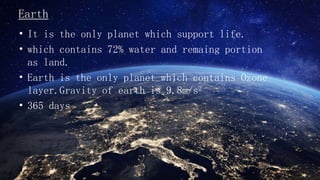Astonomy.pptx
- 2. • Introduction. • Astronomy. • Types. • Sun,Moon, Planets,Stars & Galaxy We have to see.....
- 3. • Humans are always curious about Nature. • Little tiny light spot. • He also noticed the Unique phenomenon Which are Supportive and also some are Destructive. • After they started to name things. like Star , Planet ,..etc Introduction
- 4. • Earth is Flat.
- 5. • Depending on the diffrent stars the Weather changes . • How day and night happens, • How eclipse happens. • All these observations and study leads to Development of new Branch called Astronomy.
- 6. Astronomy • Astronomy is the study of everything in the Univers beyond earths atmosphere.That include object we can see with our naked eyes. Like Sun ,Moon, Planets and stars. Two types 1. Observational Astronomy: Which is the method of studing univers by using Telescope & camera.
- 7. 2. Theoritical Astronomy: Theorotical study of the universe using the data which is obtained by the Observational Astronomy We shall see about some stellar object like SUN , MOON, PLANETS,STARS & GALAXY. Light-year is the distance light travels in one year. Light zips through interstellar space at 186,000 miles (300,000 kilometers) per second and 5.88 trillion miles (9.46 trillion kilometers) per year
- 8. SUN ball of Plasma. • Nuclear fusion reaction. • Sun is made One of the nearest star to us. • made up of 73% of Hydrogen ,25% of Helium & 2% other gases. • Core fuses around 600 Million TONS of Hydrogen into helium per sec. • Energy takes 10000 years to escape from core to the outer shell.
- 9. • The energy is mainly as visible light,UV Radiation & Infrared radiation. • The size of the sun is 106 times grater than the size of Earth. • 99.86% total mass of the Solar system.(S.S) • Distance b/w Sun & Earth is called as Astronomical Unit. • 150 million km = 1au
- 10. MOON • Name? • Natural satellite. • 384400km distance from earth.0.002441au • 5th Largest Natural satellite in our S.S. • 27 Days to complete one round around its orbit. • Age...? • 4.53 Billion year old
- 11. • we can only see the one face of the Moon. • Depending on the evoluvation Full moon day and No moon day happens once in 15 days. • it only reflects part of the Sun light. • Moon looks bigger than the sun but actually moon is samller, this is becuase of Distance between them w.r.to earth.
- 12. Planets. • 8 planets are in our solar system. • Made up of ROCK, GAS & Ice. • Based on this planets are divided Three set. • ROCKY: Mercury, Venus, Earth & Mars. • GAS Gaints: Jupitar, Saturn. • Ice Gaints: Uranus, Neptune.
- 13. • There is also Planets beyond Neptune. • They are called Exoplanets. • we shall see one by one.
- 14. Mercury • Smallest. • Closest.(0.4Au) • It does not have moon.1day =59day • 88 days.3.7m/s2 Venus Hottest planet.(4560c) Green house effect.0.7au 224 days
- 15. Earth • It is the only planet which support life. • which contains 72% water and remaing portion as land. • Earth is the only planet which contains Ozone layer.Gravity of earth is 9.8m/s2 • 365 days.
- 16. Mars • Dusty,Cold Desert. • Thin atmosphere. • Contains water. • 687 days. Jupiter Biggest.hard to see surface,1300 earth. Great red spot.It have 79 moons. 4333 days.
- 17. Saturn • Ring.2nd largest. • Dust & Gas. • 10,759 days. • Uranus • Coldest,Distance of 2.88 Billion km • 900 Tilt • Looks like Rolling.Blue dot. • 30,687Days
- 18. • Distant Planet. • cold & Dark. • 17 times heaviour than earth. • Supersonic wind are there. • 60,190 days. Neptune
- 20. • Star is a massive self luminous celestial body of gas that shines by radiation derived from its internal energy Source. • They have life cycle.like we humans. • That depends on amount of gas present in it. • They made up of helium and Hydrogen. Stars.
- 21. • Nebula. • Nuclear fusion reaction. • Hydrogen into Helium. • 3000 stars we can see in our night sky. • 1022 stars in our Galaxy. • constellation • A constellation is a group of stars that appears to form a pattern or picture.
- 22. What are the 12 constellation of the zodiac One constellation tradition is the western zodiac, which is made up of 12 constellations Aries, Taurus, Gemini, Cancer, Leo, Virgo, Libra, Scorpius, Sagittarius, Capricornus, Aquarius, and Pisces
- 23. Galaxy • Galaxy is a collection of all Stars, Planets, Satellites. • 2 Trillion galaxies in our Space. • Each of them of Diffrent size. 4 type of Galaxies 1. Spiral. 2. Elliptical 3. peculiar 4. Irregular
- 24. • Milky Way • Appears as Milk spread in sky, • 10X1017km . • Milky way is Spiral in shape. • Radius of 52850 L.Y • https://youtu.be/libKVRa01L8
- 25. Thankyou.
























